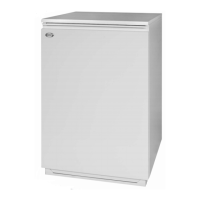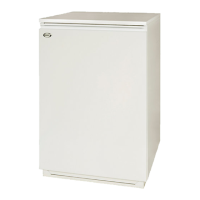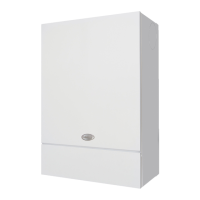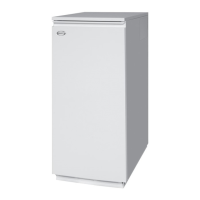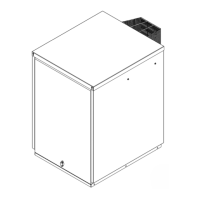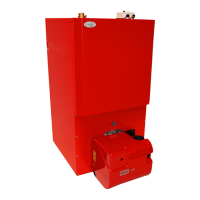Boiler Installation
Information
13
The air charge pressure may be
checked using a tyre pressure gauge on
the expansion vessel Schraeder valve.
The vessel may be re-pressurised using
a suitable pump. When checking the air
pressure the water in the heating
system must be cold and the system
pressure reduced to zero.
4.6 Filling and Venting
the System
Automatic and manual air vents
The boiler is fitted with two Automatic
air vents at the top of the boiler, located
as follows:
• one on the top of the primary store
• one on the heating flow pipe
Refer to Figure 5-1.
Check that the small black plug on the
side of each air vent is screwed in fully.
Then unscrew it one complete turn - the
cap remains in this position thereafter.
A single manual air vent is also fitted at
the top of the boiler - on the return pipe.
Unscrew the cap one turn vent air from
the pipe during filling and then fully close
the cap.
Filling loop
If the flexible filling loop is used to fill the
system, ensure it is connected and that
the valve connecting it to the boiler is
open and the valve at the front is
closed.
A valve is open when the operating lever
is in line with the valve, and closed
when it is at right angles to it.
Ensure that the mains cold water supply
valve is open (operating lever in line with
the valve), then turn on the mains cold
water supply and gradually open the
front valve on the filling loop until water
is heard to flow.
Vent each radiator in turn, starting with
the lowest one in the system, to remove
air.
It is important the circulating pumps are
properly vented to avoid them running
dry and the bearings being damaged.
Unscrew and remove the plug from the
centre of the pump. Using a suitable
screwdriver rotate the exposed spindle
about one turn. When water starts to
trickle out, replace the plug.
The Hot water pump must also be
vented as described above.
Check the operation of the safety valve
by turning the head anticlockwise until it
clicks. The click is the safety valve head
lifting off its seat allowing water to
escape from the system. Check that
this is actually happening.
Continue to fill the system until the
pressure gauge indicates between 0.5
and 1.0 bar. Close the fill point valve
and check the system for water
soundness, rectifying where necessary.
Water may be released from the system
by manually operating the safety valve
until the system design pressure is
obtained.
The system design pressure (cold)
should be between 0.5 bar and 1.0 bar.
The pressure is equivalent to the
maximum static head in bar + 0.3 (1 bar
= 10.2 metres of water), where the
static head is the vertical height from the
centre of the expansion vessel to the
highest point of the system.
Close the valves either side of the filling
loop and disconnect the loop.
4.7 Regulatory Compliance
Requirements
Installation of a Grant VORTEX Pro
External Combi e must be in
accordance with the following
recommendations:-
• Building Regulations for England
and Wales, and the Building
Standards for Scotland issued by
the Department of the Environment
and any local Byelaws which you
must check with the local authority
for the area.
• Model and local Water Undertaking
Byelaws.
• Applicable Control of Pollution
Regulations.
• The following OFTEC requirements:
• OFS T100 Polythene oil storage
tanks for distillate fuels.
• OFS T200 Fuel oil storage tanks
and tank bunds for use with
distillate fuels, lubrication oils and
waste oils.
4. The electrical supply to the boiler
should be routed through the wall in
a suitable conduit, such that it
enters the boiler enclosure via one
of the unused pipework openings.
The cable can be routed to the front
of the boiler, for connection to the
boiler control panel, either over the
top or beneath the boiler heat
exchanger. Heat resistant PVC
cable, of at least 1.0mm² cross
section should be used within the
boiler enclosure. See section 8.1 for
details.
5. The oil supply line should be
installed up to the position of the
boiler. Refer to Section 3 for details.
The final connection into the boiler
enclosure can be made with 10mm
soft copper, routed along the base
of the enclosure (either between the
enclosure and wall or in front of the
enclosure) to enter through one of
the holes located in the bottom
edge side panel, at the front (burner)
end. See Section 3 for details.
4.5 Expansion Vessel
The expansion vessel fitted is supplied
with a charge pressure of 1.0 bar
(equivalent to a max. static head of 10.2
metres). The charge pressure must not
be less than the actual static head at
the point of connection. Do not
pressurise the vessel above 1.5 bar.
The air pressure in the vessel must
be checked annually.
The central heating system volume,
using the expansion vessel as supplied,
must not exceed the recommended
volumes. If the system volume is
greater, an extra expansion vessel
(complying with BS4841) must be fitted
as close as possible to the central
heating return connection on the boiler.
The charge pressure of the extra vessel
must be the same as the vessel fitted in
the boiler. Refer to BS7074:1 for further
guidance.
!
NOTE
